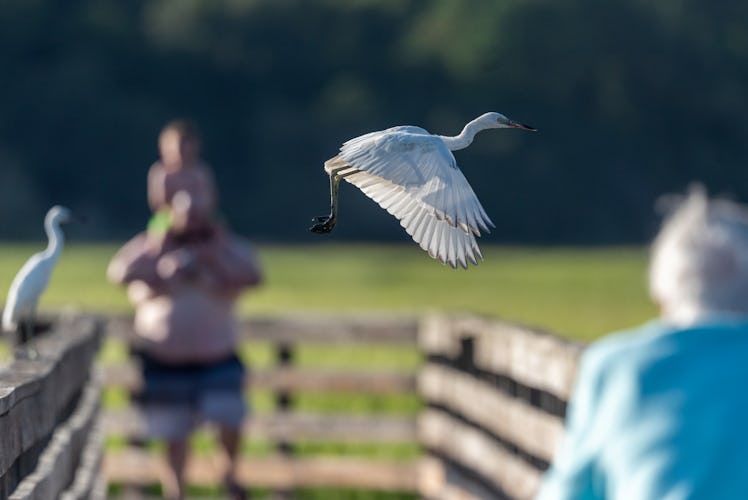Turn Your Backyard Into A Nature Center By Teaching Your Kids About Bird Watching
Put a bird on it.

Bird watching — or birding — is an incredible pursuit. It’s a reason to go outside, to calm your mind, to look away from the stresses on the ground and up to the serene quiet of the sky. But to kids, it can seem a little underwhelming. It doesn’t have to be. Chris Lajewski is the director at the Montezuma Audubon Center, 200 acres of birding paradise in upstate New York, and has gotten tons of kids (including his own) into scoping out the natural avian beauty. His advice? Get started with a bird house, then watch the interest grow.
Let The Birds Come To You
Early on in his kids’ lives, Lajewski put up bird feeders and bird boxes to transform his yard into a feathered Ritz Carlton. When you get them literally flocking to the front of your house, you can start pointing out different species while everyone is having breakfast. Here are a few ways to prep your yard:
- Plant native vegetation. You’re going to want to make a place for them to nest, but also choose plants that yield seeds or berries, so they have a snack.
- Fill feeders with black oil sunflower seeds or thistle seed. Don’t buy mixes that have a lot of filler. Just like your kid that only eats hot dogs, it has no nutritional benefit.
- That thing about the early bird? Totally true. But morning isn’t the only time that birds are active. You can also do some spotting early evening — especially in the winter when they’re putting on some extra ounces to survive the overnight elements.
- Birds need liquid water during the winter or they’ll die from dehydration. Get a simple heater in your bird bath to make sure they can drink.
Follow That Bird
There’s no wrong season to spot, but springtime (when the birds and the bees have that talk … about themselves) is peak bird watching time. “Migratory season is a great time of year to watch the birds as they come through,” says Lajewski. “Songbirds move up from South America, where they migrate north along flyways. These are basically highways for birds.” The Audubon Society has one good roadmap that will tell you what flyways run through your town.
Or you can check out ebird.org to see what species have been spotted in your state.
The Best Bird Watching Binoculars
All you need to go outside to bird watch is a field guide and a decent pair of binoculars. Lajewski owns a pair of Bushnell Elites, which give him a wider field of view and higher magnification. The next step up is a pair of Vortex if you’re looking to spot a chickadee in the next state over. But, your kid isn’t going to need that. Instead, start them off with something like Carson Hawk Child Binoculars, which are sized for kids’ heads. They’re durable, lightweight, but still have adult-powered magnification.
The Right Bird Watching Field Guide
The gold-standard guide for bird watchers is Sibley’s Guide To Birds. But if you want to be hip with the kids, you can get the same thing in app form. Here are two that you should be adding to your “Birding” folder:
- Audubon Birds: (iOS) (Android) (Amazon) “It’s a free app and has over 800 species across North America. Each species has 5 or 6 photographs, plus 5 or 6 different calls. It’s a great tool to have. I use it when I give my tours.”
- Merlin: Free (iOS) (Android) “It’s a bird ID app from the Cornell Lab of Ornithology. You enter some info about the bird you’re trying to identify, like any distinguishing features, and the app will give you some names of the bird you’re looking at.”
Seek Bird Sanctuaries
There is no shortage of birds outside your window (taking a shit on your car). But if you want to see some real diversity, get out to a bird sanctuary. Unfortunately, your state may or may not have an Audubon Center (there are only 40 in the U.S.), but they have mapped out every important bird area across the country.
Gone “Pishing”
“A tool I use outside of the breeding season is called pishing,” says Lajewski, which sounds dirtier than it is. “That’s the sound made by songbirds to alert other birds in their family or their species of some disturbance in their habitat. Chickadees, woodpeckers, and Tufted Titmice are attracted to those sounds.” Yes, your kids are allowed to say titmouse.
Some Games To Pass The Time
Even a devoted bird watcher like Lajewski will admit that birding requires patience. If your kid hasn’t quite nailed that life skill yet, here are a few ways to trick them into thinking they’re occupied.
- Bird Bingo: Take nine different bird photos (local birds — or else they’ll spend years looking for a penguin in the Midwest) and paste them on a bingo card. Let your kids spend hours trying to black out that card.
- Name That Tune: For younger kids, get a round of “what’s that sound?” going. “Sandhill cranes sound like trumpets off in the distance. Woodpeckers are drumming in the trees. Some birds are whistling and singing, so it’s like getting the band back together in the springtime.” That band? The Byrds.
Learn The Bird Watching Lingo
Birders have a whole Urban Dictionary to themselves. One of the words that Lajewski uses with his kids when he doesn’t know what the hell they’re looking at is just to call it an LBJ, or Little Brown Job. Some other favorites you may want to bust out: Butterbutt, Purple Pooper, and the Spark Bird. That last one would be the term for first species that turns your kid onto birding for life.
This article was originally published on